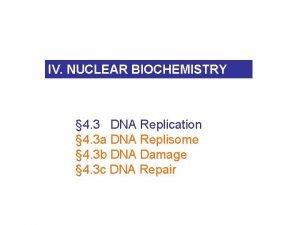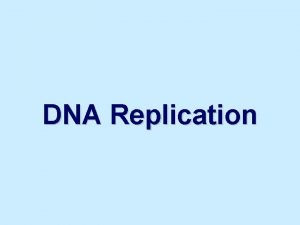HAPPY MONDAY DNA REPLICATION Mitosis Occurs during S








- Slides: 8

HAPPY MONDAY!

DNA REPLICATION • Mitosis – • Occurs during S phase of interphase • • Allows for copies of DNA to be created New DNA needs to be created for new cells DNA replication is called Semi-conservative Uses Complementary Base Pairing rules (CBP)

DNA REPLICATION 7. 2 • DNA replication occurs in a 5’ to 3’ direction • Replication begins at a particular sequence of nucleotides called the origins of replication

• It is at these points that a special enzyme called helicase splits the DNA into its two antiparallel strands. • Completes the separation of the two strands by breaking the hydrogen bonds between the pyramidines and purines. • The opening of the two strands is called the replication bubble

• Once the strands are separated another enzyme called DNA Polymerase will start reading and creating a new DNA strand. • This DNA Polymerase uses Complementary Base Pairing Rules (CBP) • A bonds with T • G bonds with C

·Complimentary base pairing rules are used - A bonds with T - C bonds with G ·This ensures - the correct base is incorporated into the new DNA strand - conservation of the base sequence - the newly formed strand is identical to the old strand it is replacing

DNA replication is semiconservative. ·the 2 strands of the original molecule are each used as a template for the formation of the new strands. ·The result is two newly formed strands that each consist of one old strand one new strand

animation further reading on experiments to confirm semiconservative replication: p 250 -251















